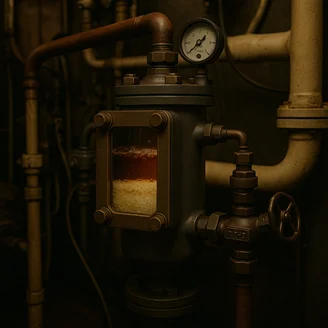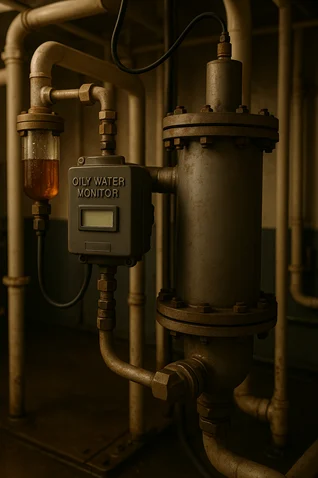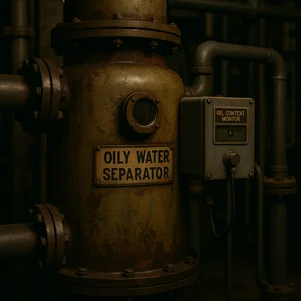What Every Engineer Should Know
Down in the engine room, tucked between all the pipes, valves, and pumps, there’s a piece of equipment that doesn’t get much attention until something goes wrong.
It’s the Oily Water Separator, or OWS.
It quietly does its job, day in and day out. But when it’s not working properly or worse, when someone tries to cheat it things can go south really fast. Detentions. Fines. Investigations. Careers ruined.
In this post, let’s break down what the OWS actually does, why it matters, the common mistakes people make, and how simple, honest routines can keep everything running smoothly.
What’s the OWS, and Why Should You Care?
The OWS is there to clean up bilge water that oily mess that builds up under the engine room from leaks, drains, and general operations. The system separates the oil from the water, and (if everything is working right) only lets out water with less than 15 parts per million (ppm) of oil.
That’s the legal limit under MARPOL Annex I. If your ship is over 400 GT, you have to have an OWS. Over 10,000 GT? Then you’ll also need an Oil Content Meter (OCM) and auto-stop functions built in.
Why is that 15 ppm limit such a big deal? Because if you go over it, you’re polluting. And in today’s shipping world, getting caught dumping oily water can mean huge fines, port delays, and a massive hit to your personal and ship’s reputation.
That Sampling Point Everyone Forgets About
One small thing that inspectors love to check? The sampling points.
According to MARPOL rules (MEPC.107(49)), the OWS sample point the part that shows the oil content in discharged water should be installed on a vertical section of pipe, right after the OWS.
Why vertical? Because oil floats. If your pipe is horizontal, some oil may stick to the top and give a false clean reading. That’s why it has to be vertical to show what’s really going overboard.
Quick check: On your next round, take a look at your sample point. Is it where it should be? If it’s wrong, say something. Fix it before it turns into a detention.

The Oil Content Meter (OCM): Your 15 ppm Watchdog
The OCM (or the 15-ppm alarm) constantly checks the water coming out of the OWS. If the oil content is too high, the system should automatically stop the discharge or divert it back for treatment.
Newer OCMs also have data loggers, which keep track of every discharge when, how long, how much, and how oily. Port inspectors use that data and compare it with the Oil Record Book. So, make sure both matches up.
Pro tip: If you ever replace the OCM, keep the old data safe you’re required to store it for at least 18 months.
The “Shortcuts” That Can Ruin Everything
Sadly, there are still people out there who try to cheat the system. Whether it’s to save time or avoid paperwork, it’s just not worth it.
Here are a few tricks inspectors know all too well:
1. Flushing Trick
Some try to make the OCM read clean water by opening the flushing line while keeping the sample valve closed. It fools the system for a moment. But most modern OCMs can detect this and throw up an alarm.
2. Bypassing the Sample
Some people leave the sample valve closed permanently, forcing a constant “clean” reading. If an inspector sees oil in the discharge pipe or residue inside, you’re done.
3. The “Magic Pipe”
You’ve probably heard this one before illegal bypasses, extra flanges, or welded shut covers hiding secret discharge lines. These are serious offenses. If discovered, they can lead to suspensions, fines, or even jail time.
What Good Practice Actually Looks Like
Forget the shortcuts. Just focus on doing the right things every day. Here’s what that looks like:
- Keep an eye on the OCM readings don’t just rely on alarms.
- Clean the coalescer and filters A dirty separator doesn’t separate anything.
- Fill out the Oil Record Book (ORB) properly no shortcuts, no guessing.
- Test the auto-stop function once a month to make sure it still works.
- Teach junior engineers how the system really works. Don’t let them pick up bad habits.

The Real Challenge? It’s Not the Machine. It’s the Mindset.
Most of the time, the equipment works fine. What doesn’t always work is the mindset of the people using it.
When someone says:
“It’s fine, no one will check.”
or
“Let’s fix it later.”
That’s when trouble starts.
Being a good engineer means doing the right thing, even when no one’s watching. Especially then.
Because how you treat your OWS doesn’t just show how well you follow rules it shows the kind of professional you are. And the kind of legacy you leave behind onboard.
Final Words from Nav Insider
It’s easy to think of the OWS as just another box to tick. But in reality, it’s part of something much bigger keeping our oceans clean, staying compliant, and showing pride in what we do.
So next time you’re in the engine room, give that separator a second look. It may not be glamorous, but it’s one of the most important pieces of equipment down there.


